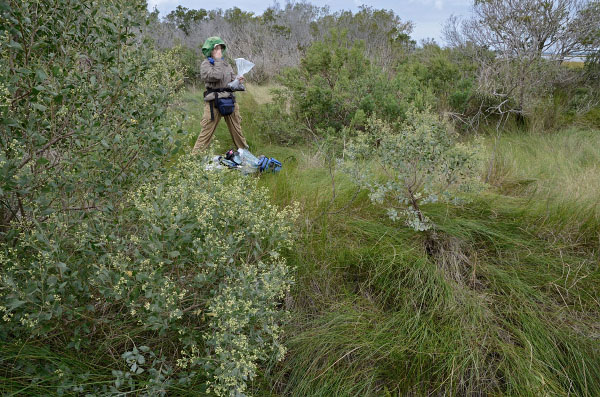

Virginia Department of Conservation and RecreationAn official website of the Commonwealth of Virginia Here's how you knowAn official websiteHere's how you know

Virginia Department of Conservation and RecreationAn official website of the Commonwealth of Virginia Here's how you knowAn official websiteHere's how you know
 Department of Conservation and Recreation
Department of Conservation and Recreation
 Table of Contents
Table of ContentsSalt Scrub
This group is characterized by halophytic, shrub-dominated vegetation. Salt scrub communities are wide-ranging along the Atlantic and Gulf coasts of the United States. In Virginia, they are found in saline environments throughout the outer Coastal Plain and along lower reaches of major rivers on the inner Coastal Plain. Although salt scrub does occur in tidal habitats, it more commonly occupies higher, only irregularly flooded landscape positions in a mosaic with lower, diurnally flooded salt marsh. Salt scrub stands are strongly influenced by high winds and salt spray typical of their maritime environments. High-tide bush (Baccharis halimifolia) and marsh-elder (Iva frutescens) are the usual woody dominants. Saltgrass (Distichlis spicata), saltmeadow cordgrass (Spartina patens), wax myrtle (Morella cerifera), and swamp rose-mallow (Hibiscus moscheutos) are common associates.
References: Coulling (2002), Levy (1983), The Nature Conservancy (1997).Click here for more photos of this ecological community group.
 © DCR-DNH, Gary P. Fleming.
© DCR-DNH, Gary P. Fleming.
Although the single community type in this group is based on only seven plots (Fig. 1), it has been qualitatively documented from numerous other sites on the outer Coastal Plain and clearly represents an easily recognizable and widespread association in the USNVC. The collection and analysis of additional data are unlikely to change the classification. Click on any highlighted CEGL code below to view the global USNVC description provided by NatureServe Explorer.

 Download a spreadsheet of compositional summary statistics (Excel) for each of the community types listed below.
Download a spreadsheet of compositional summary statistics (Excel) for each of the community types listed below.

